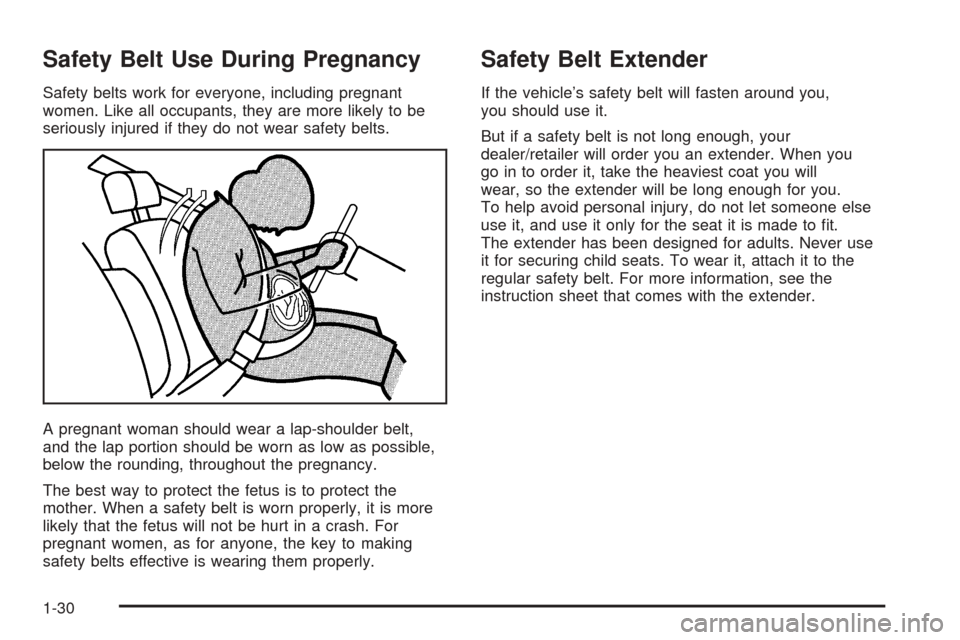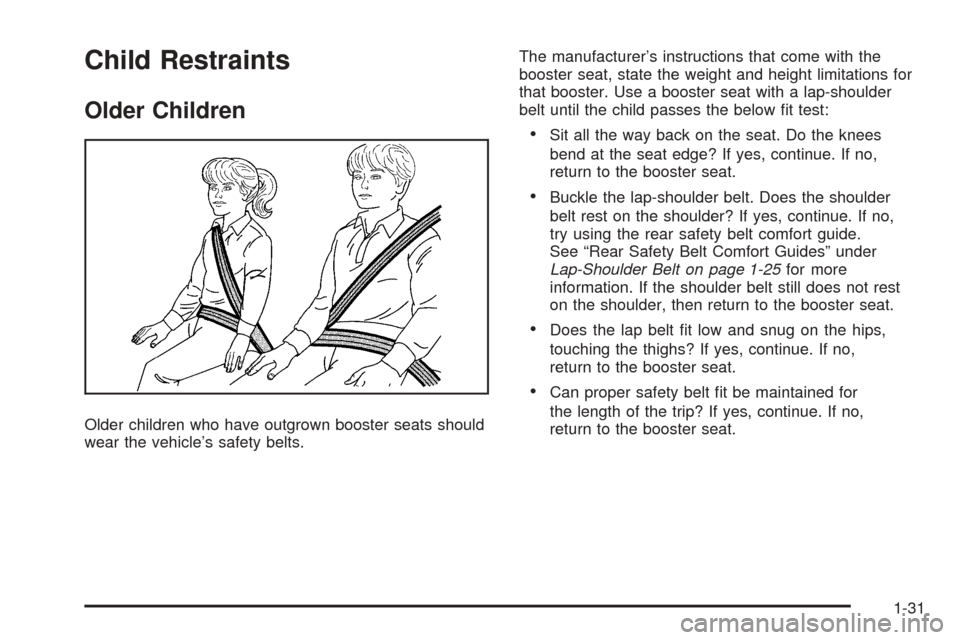Page 28 of 436
Q:What is wrong with this?
A:The belt is twisted across the body.
{CAUTION:
You can be seriously injured by a twisted belt.
In a crash, you would not have the full width
of the belt to spread impact forces. If a belt
is twisted, make it straight so it can work
properly, or ask your dealer/retailer to �x it.
1-24
Page 29 of 436

Lap-Shoulder Belt
All seating positions in your vehicle have a
lap-shoulder belt.
Here is how to wear a lap-shoulder belt properly.
1. Adjust the seat, if the seat is adjustable, so you
can sit up straight. To see how, see “Seats” in
the Index.
2. Pick up the latch plate and pull the belt across you.
Do not let it get twisted.
The lap-shoulder belt may lock if you pull the belt
across you very quickly. If this happens, let the
belt go back slightly to unlock it. Then pull the belt
across you more slowly.
If you ever pull the shoulder portion of a passenger
belt out all the way, you may engage the child
restraint locking feature. If this happens, just let
the belt go back all the way and start again.3. Push the latch plate into the buckle until it clicks.
Pull up on the latch plate to make sure it is secure.
If the belt is not long enough, seeSafety Belt
Extender on page 1-30.
Make sure the release button on the buckle is
positioned so you would be able to unbuckle the
safety belt quickly if necessary.
4. If equipped with a shoulder belt height adjuster,
move it to the height that is right for you. Improper
shoulder belt height adjustment could reduce
the effectiveness of the safety belt in a crash.
See “Shoulder Belt Height Adjustment” later
in this section.
1-25
Page 30 of 436
5. To make the lap part tight, pull up on the
shoulder belt.
It may be necessary to pull stitching on the
safety belt through the latch plate to fully
tighten the lap belt on smaller occupants.To unlatch the belt, just push the button on the buckle.
For outboard seating positions, when the safety
belt is not in use, slide the latch plate up the safety
belt webbing. The latch plate should rest on the
stitching on the safety belt, near the guide loop.
Before you close a door, be sure the belt is out of
the way. If you slam the door on it, you can damage
both the belt and your vehicle.
1-26
Page 31 of 436

Shoulder Belt Height Adjuster
Your vehicle has a shoulder belt height adjuster for
the driver and right front passenger.
Adjust the height so that the shoulder portion of the
belt is centered on your shoulder. The belt should
be away from your face and neck, but not falling off
your shoulder. Improper shoulder belt height adjustment
could reduce the effectiveness of the safety belt
in a crash.
To move it up or down,
squeeze the release
buttons (A) together and
move the height adjuster
to the desired position.
After you move the height adjuster to where you want it,
try to move it up or down without squeezing the release
buttons to make sure it has locked into position.
Safety Belt Pretensioners
Your vehicle has safety belt pretensioners for front
outboard occupants. Although you cannot see them,
they are part of the safety belt assembly. They can
help tighten the safety belts during the early stages of
a moderate to severe frontal and near frontal crash if
the threshold conditions for pretensioner activation
are met.
Pretensioners work only once. If they activate in a
crash, you will need to get new ones, and probably other
new parts for your safety belt system. SeeReplacing
Restraint System Parts After a Crash on page 1-73.
Rear Safety Belt Comfort Guides
Rear shoulder belt comfort guides may provide added
safety belt comfort for older children who have outgrown
booster seats and for some adults. When installed on
a shoulder belt, the comfort guide positions the belt
away from the neck and head.
1-27
Page 32 of 436
There is one guide for each outside passenger position
in the rear seat. Here is how to install the comfort
guide to the shoulder belt:
1. Remove the guide from its storage clip on the
back of the seatback.
2. Place the guide over the belt, and insert the
two edges of the belt into the slots of the guide.3. Be sure that the belt is not twisted and it lies �at.
The elastic cord must be under the belt and the
guide on top.
1-28
Page 33 of 436
{CAUTION:
A safety belt that is not properly worn may not
provide the protection needed in a crash. The
person wearing the belt could be seriously
injured. The shoulder belt should go over the
shoulder and across the chest. These parts of
the body are best able to take belt restraining
forces.
4. Buckle, position, and release the safety belt as
described previously in this section. Make sure
that the shoulder belt crosses the shoulder.
To remove and store the comfort guide, squeeze the
belt edges together so that you can take them out
of the guide. Slide the guide back onto its storage clip
located on the seatback.
1-29
Page 34 of 436

Safety Belt Use During Pregnancy
Safety belts work for everyone, including pregnant
women. Like all occupants, they are more likely to be
seriously injured if they do not wear safety belts.
A pregnant woman should wear a lap-shoulder belt,
and the lap portion should be worn as low as possible,
below the rounding, throughout the pregnancy.
The best way to protect the fetus is to protect the
mother. When a safety belt is worn properly, it is more
likely that the fetus will not be hurt in a crash. For
pregnant women, as for anyone, the key to making
safety belts effective is wearing them properly.
Safety Belt Extender
If the vehicle’s safety belt will fasten around you,
you should use it.
But if a safety belt is not long enough, your
dealer/retailer will order you an extender. When you
go in to order it, take the heaviest coat you will
wear, so the extender will be long enough for you.
To help avoid personal injury, do not let someone else
use it, and use it only for the seat it is made to �t.
The extender has been designed for adults. Never use
it for securing child seats. To wear it, attach it to the
regular safety belt. For more information, see the
instruction sheet that comes with the extender.
1-30
Page 35 of 436

Child Restraints
Older Children
Older children who have outgrown booster seats should
wear the vehicle’s safety belts.The manufacturer’s instructions that come with the
booster seat, state the weight and height limitations for
that booster. Use a booster seat with a lap-shoulder
belt until the child passes the below �t test:
Sit all the way back on the seat. Do the knees
bend at the seat edge? If yes, continue. If no,
return to the booster seat.
Buckle the lap-shoulder belt. Does the shoulder
belt rest on the shoulder? If yes, continue. If no,
try using the rear safety belt comfort guide.
See “Rear Safety Belt Comfort Guides” under
Lap-Shoulder Belt on page 1-25for more
information. If the shoulder belt still does not rest
on the shoulder, then return to the booster seat.
Does the lap belt �t low and snug on the hips,
touching the thighs? If yes, continue. If no,
return to the booster seat.
Can proper safety belt �t be maintained for
the length of the trip? If yes, continue. If no,
return to the booster seat.
1-31